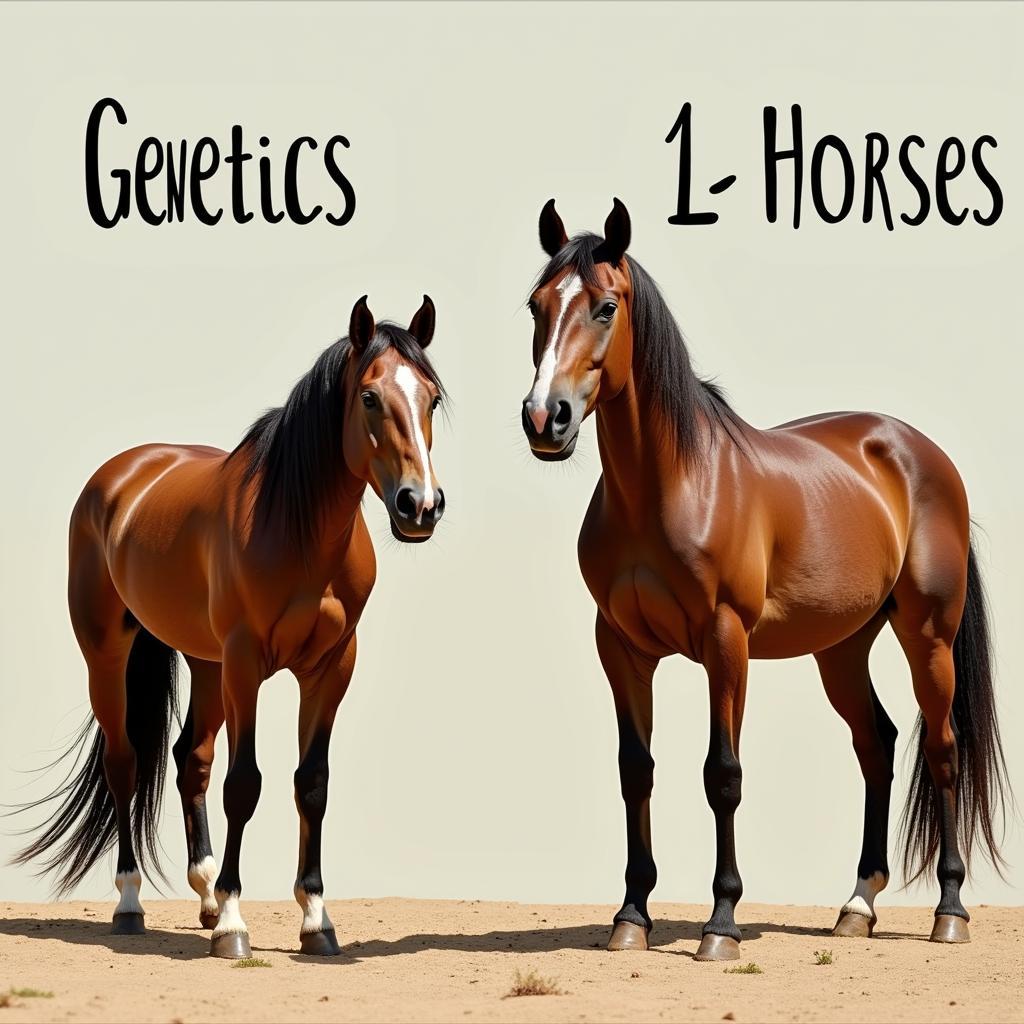Understanding horse genetics crosses involving two traits requires a grasp of Mendelian inheritance and the concept of a dihybrid cross. This approach helps predict the potential offspring genotypes and phenotypes when breeding horses with consideration for two distinct traits. Finding the “answer key” lies in carefully analyzing the parent genotypes and applying the principles of inheritance.
Decoding the Dihybrid Cross in Horse Genetics
Dihybrid crosses, unlike monohybrid crosses which focus on a single trait, examine the inheritance of two separate traits simultaneously. A classic example is coat color and gait. Let’s say we’re looking at a cross between two horses, both heterozygous for both coat color (black dominant over chestnut) and gait (trotting dominant over pacing). The genotype of both parents would be BbTt, where B represents the black allele, b represents the chestnut allele, T represents the trotting allele, and t represents the pacing allele.
Punnett Squares and Probability in Two-Trait Crosses
The Punnett square is an invaluable tool for visualizing and calculating the potential offspring genotypes and phenotypes. In a dihybrid cross, the Punnett square becomes a 4×4 grid, representing the possible combinations of alleles from each parent. Using our example, the possible gametes for each parent are BT, Bt, bT, and bt. The Punnett square would then show the 16 possible combinations of these gametes, allowing us to determine the probability of each genotype and phenotype in the offspring.
Beyond Basic Mendelian Inheritance: Epistasis and Other Factors
While Mendelian genetics provides a solid foundation, it’s crucial to remember that real-world horse genetics can be more complex. Factors like epistasis, where one gene influences the expression of another, can significantly impact the observed phenotypes. For example, the presence of a dilution gene can modify the base coat color, leading to palomino or cremello variations even if the underlying genotype suggests black or chestnut.
Environmental Influences on Phenotype
Environmental factors also play a role in the expression of certain traits. Nutrition, training, and overall health can influence a horse’s size, musculature, and even coat condition. These factors, while not genetically determined, contribute to the overall phenotype and must be considered.
 Environmental Factors Influencing Horse Phenotype
Environmental Factors Influencing Horse Phenotype
Predicting and Interpreting Horse Genetics Crosses
Accurately predicting the outcomes of horse genetics crosses requires careful consideration of both parental genotypes and potential modifying factors. While the Punnett square provides a starting point, understanding the complexities of gene interactions and environmental influences is essential for a comprehensive analysis.
Utilizing Genetic Testing for Accurate Breeding
Modern genetic testing provides valuable insights into a horse’s genotype, helping breeders make informed decisions. These tests can identify specific genes responsible for coat color, gait, and other traits, providing a more precise “answer key” than traditional pedigree analysis alone.
“Understanding the nuances of equine genetics is essential for responsible breeding,” says Dr. Sarah Mitchell, equine geneticist. “Utilizing genetic testing alongside traditional methods allows breeders to make more informed decisions, improving the health and quality of future generations.”
Conclusion
Mastering the “Horse Genetics Crosses Involving Two Traits Answer Key” involves understanding Mendelian inheritance, using Punnett squares, and acknowledging the influence of epistasis and environmental factors. Combining these principles with modern genetic testing empowers breeders to predict and interpret genetic crosses more accurately, ultimately contributing to healthier and more desirable horse populations. Remember, continuous learning and staying updated on advancements in equine genetics are crucial for success in horse breeding.
FAQ
- What is a dihybrid cross?
- How do environmental factors influence horse phenotype?
- What is the role of genetic testing in horse breeding?
- How can I use a Punnett square to predict offspring genotypes?
- What is epistasis and how does it affect horse genetics?
- What are some examples of two traits that can be analyzed in a dihybrid cross in horses?
- Where can I find reliable resources for learning more about horse genetics?
Need assistance? Contact us 24/7: Phone: 0772127271, Email: [email protected] Or visit us at: QGM2+WX2, Vị Trung, Vị Thuỷ, Hậu Giang, Việt Nam.